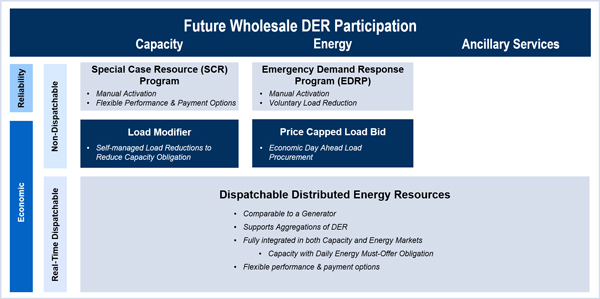By William Opalka
Responding to policy initiatives from Washington and Albany, NYISO last week released a “road map” for integrating distributed energy resources that seeks to build on the grid operator’s existing markets and demand response programs.
The ISO said the draft report was a response to the New York Public Service Commission’s Reforming the Energy Vision initiative, and FERC Orders 719 and 745, which require the ISO to give DR greater access to real-time markets. NYISO says it provides a framework for market rules that will be developed over the next three to five years to implement the state and federal policies.
Demand Elasticity
NYISO said it agrees with the PSC that DER “can make load more dynamic and responsive to wholesale market price signals.”
The PSC says DER can improve system efficiency if their value is properly reflected in retail and wholesale markets and if utilities are incented to consider them as alternatives to traditional capital investments. The commission envisions the creation of distribution system platform (DSP) providers that plan, operate and administer markets for distribution-level services.
NYISO said REV is largely consistent with how the ISO “administers wholesale markets, plans for bulk system needs and operates the grid.”
Competitive wholesale markets, the ISO notes, were designed in part to facilitate demand-side elasticity. “For a variety of reasons, ranging from the economics and limitations of enabling technologies, this demand elasticity has failed to materialize to a significant degree.”
But with improved technology and economic models, NYISO said, integrating DER into the wholesale markets could “build upon the efficiencies already realized under competitive wholesale market structures.”
‘A Desire to Participate’
The ISO said its new rules will accommodate “controllable resources with various capabilities and a desire to participate in the wholesale markets.”
The report says DER will be incented through economic dispatch and real-time locational prices “that [align] compensation with system requirements.”
“The NYISO intends for the DER program to align incentives and compensation based on the flexibility and measured performance of the DER (or aggregation), and market clearing prices based on the needs of the system. The intent is to treat DER comparably with other supply resources participating in the NYISO’s energy, capacity and ancillary services markets.”
DER participating in the capacity market will be required to offer into the energy and ancillary services markets “for all or a portion of the day, depending on the business model and capabilities of the DER.”
Changes Needed
The ISO said integrating DER will require changes to market design, system planning and grid operations.
“Realizing this goal will require an examination of DER performance obligations, operating characteristics, metering and telemetry requirements, measurement and verification of baselines and performance, market modeling, and an understanding of how to balance the simultaneous participation of DER in retail/distribution-level programs as well as the NYISO’s competitive wholesale market.”
A particular concern will be ensuring accurate load forecasts and metering.
DER will be required to provide data quality equivalent to the “Point Identifier1” metering used by large generators, with “real-time supervisory control and data acquisition (SCADA)-quality or better telemetry data for operations and monitoring functions, and after-the-fact revenue-quality meter data from individual resources for measurement and verification and settlements.”
These measurement and verification services may be performed by distribution service platform providers.
DR = DER
Going forward, NYISO said it will consider all DR as DER.
The current Special Case Resources program “has proven to be a valuable tool for planners to project load forecasts and for operators to manage system reliability” and will be retained, albeit “with potential modifications,” the report says.
The Emergency Demand Response Program and Price Capped Load Bidding also will continue. But the current Day-Ahead Demand Response and Demand Side Ancillary Services programs would be replaced.
The ISO says the report is only a beginning. “Implementing the DER initiative will entail considerable time, effort and stakeholder engagement. This road map represents a starting point for initiating discussions that will lead to further refinement on key market design elements, functional requirements and tariff language necessary to implement the vision.”




